Shade Replacement Tips for Stunning Floor Lamps
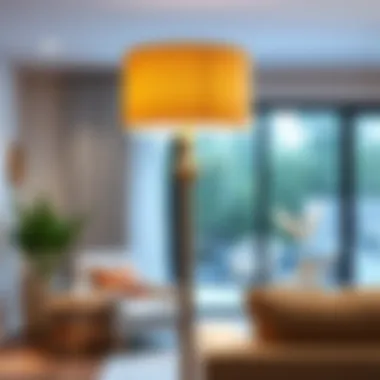
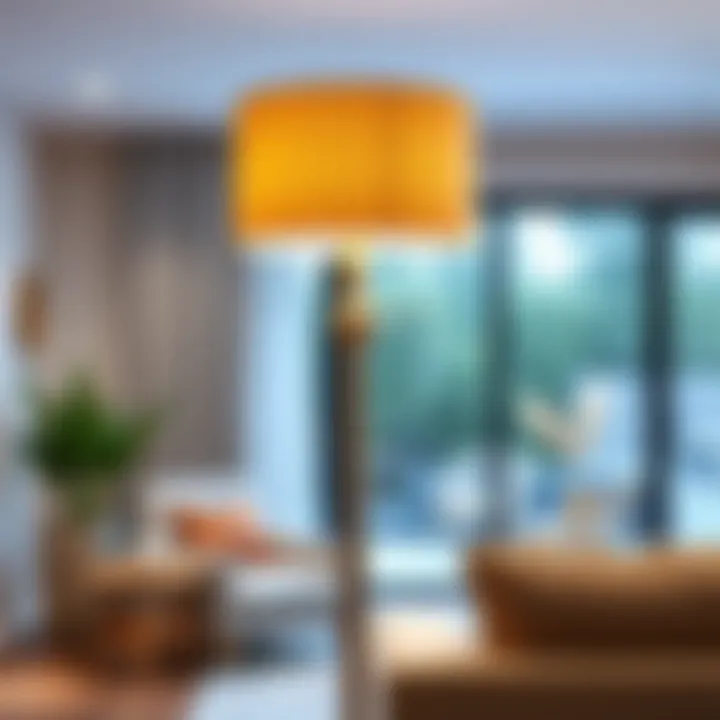
Intro
Lampshades might seem like a small detail in interior design, but they pack quite a punch when it comes to enhancing both the functionality and the elegance of a floor lamp. They ain't just there to diffuse light; their shapes, colors, and materials can dramatically influence the overall ambiance of a room. With an explosion of options in the market today, it can feel overwhelming to sift through what's available. This guide aims to demystify the variety of shades you might consider, presenting the latest trends, practical tips for selection, and useful maintenance advice to keep your lamps looking sharp.
In this exploration, we aim to arm you with the knowledge needed to make informed choices, whether you’re sprucing up your space as a homeowner, or providing a specialized touch as an interior designer. We'll break down how to choose the right shade that aligns with your style while ensuring it fits well with the intended purpose of the floor lamp. So, let’s dive into the world of shade replacements and shed some light on how you can jazz up your home lighting.
Furniture Design Trends
Current Trends in Furniture Design
In recent times, minimalism continues to dominate the design landscape. Clean lines and neutral tones allow for versatility in spaces, making it easier to match various lampshade designs. However, there's a noticeable rise in incorporating bold color choices and materials into furniture, signaling a shift towards personalization and self-expression in home design.
When it comes to lampshades specifically, materials such as linen, silk, and even metal are trending, offering a range of textures that enhance visual appeal. Furthermore, eco-friendly options are gaining traction—think shades made from sustainable materials, appealing to the environmentally-conscious homeowner. By embracing these trends, one can harmonize a space that feels both modern and inviting.
Influential Designers to Follow
Keeping an eye on contemporary designers can give one insight into future trends. Here are a few to watch:
- Kelly Wearstler: Known for her bold use of color and eclectic designs, Wearstler's approach offers great inspiration for incorporating vibrant lampshades.
- Jonathan Adler: His playful yet sophisticated approach to design is reflected in unique lampshade styles that would fit beautifully in many settings.
- Alice Temperley: With a penchant for intricate fabric patterns and luxe materials, her designs push the boundaries of conventional lamp aesthetics.
Following these designers can spur creativity and inspire recommendations for your own space or clients.
"Design is not just what it looks like and feels like. Design is how it works." — Steve Jobs
Practical Tips for Shade Selection
Choosing the Right Materials
When selecting lampshade materials, consider the light it will cast. For a warm, cozy glow, fabric shades in linen or cotton are optimal. On the other hand, glass or metal shades can create sharper, brighter light, suitable for task lighting environments. A few materials commonly considered include:
- Cotton: Soft light diffusion, easy to clean.
- Linen: Adds texture; can be translucent for a warm glow.
- Glass: Often used in modern designs, they allow for greater light output.
- Metal: Offers a contemporary look; it can be reflective or matte depending on the finish.
Maximizing Space with Smart Furniture Choices
It’s essential to opt for a shade that fits physically and stylistically into the space. Consider the lamp’s height and the area it will occupy. Practical tips here include:
- Measure the height and width of your lamp base to ensure compatibility with the shade you choose.
- Use a scale that complements the size of your room; oversized shades in small rooms can overwhelm the space.
- Think about how the shade's color and texture match with existing decor elements like curtains or upholstery.
By keeping these practical considerations in mind, you'll not only make a stylish statement but also adapt the lighting scheme well to suit the room’s purpose.
Prelims to Floor Lamp Shades
In the grand scheme of interior design, floor lamp shades might seem like mere afterthoughts, but they hold significant clout in wielding both function and style. Not only do they serve as lampshades to filter light, casting a warm, inviting glow, but they also add a touch of character to a room. It's important to understand that the shade of a floor lamp can seamlessly tie together the other elements of decor—from contemporary to vintage, every style benefits from the right lampshade selection.
Understanding the Role of Lampshades
The primary function of a lampshade is to diffuse the harshness of a light bulb while directing light where it is most needed. When you think about it, it’s kinda like the middleman in a conversation—softening the sharp edges so that everything flows nicely. This filtering of light helps create mood, depth, and ambiance in a space, which can be quite transformative. However, that isn’t all.
A lampshade acts as a protective barrier for the bulb, keeping it safe and out of direct sight, which is critical for both aesthetic and safety reasons. Plus, the material of the shade influences how much light is emitted. For instance, a translucent fabric may allow more light to escape than a dark metal shade.
- Shapes and Styles: Each shape and style also carries its own personality. A bell-shaped shade exudes traditional elegance, while a drum shade might lean toward modern minimalism.
- Colors and Patterns: The shade’s color and pattern play pivotal roles as well. A bright color can energize a room, while muted tones can create a sanctuary.
Thus, a good lampshade is not merely a cover; it’s a vital component of a room’s overall lighting plan and aesthetic flow.
When to Consider Shade Replacement
Knowing when to replace a lampshade can often be as important as choosing one. A lampshade may degrade over time due to wear and tear—think of dusty, dingy fabrics or discolored glass. If your lampshade has seen better days, showing stains, tears, or simply outdated styles, it’s time to consider a replacement.
Moreover, changing a lampshade can be a straightforward way to refresh a room without committing to a complete overhaul. If you’re looking for a change in decor or simply want to upgrade functionality, it’s a good opportunity to reassess how your current shade interacts with the overall design.
Some pointers for when to think about replacing your floor lamp shade:
- Aesthetic shifts: When you make other changes to your room, like new furniture or wall colors.
- Functionality improvements: If the lighting doesn’t suit your needs anymore, like too much glare or not enough light.
- Style updates: Embrace new trends in decor by switching out to a jaw-dropping design that complements your current setup.
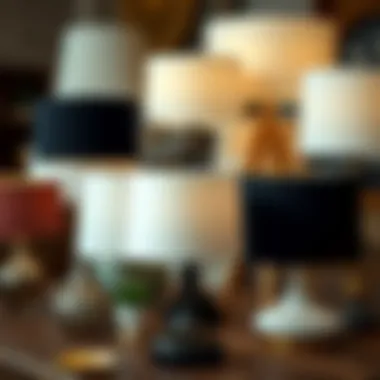
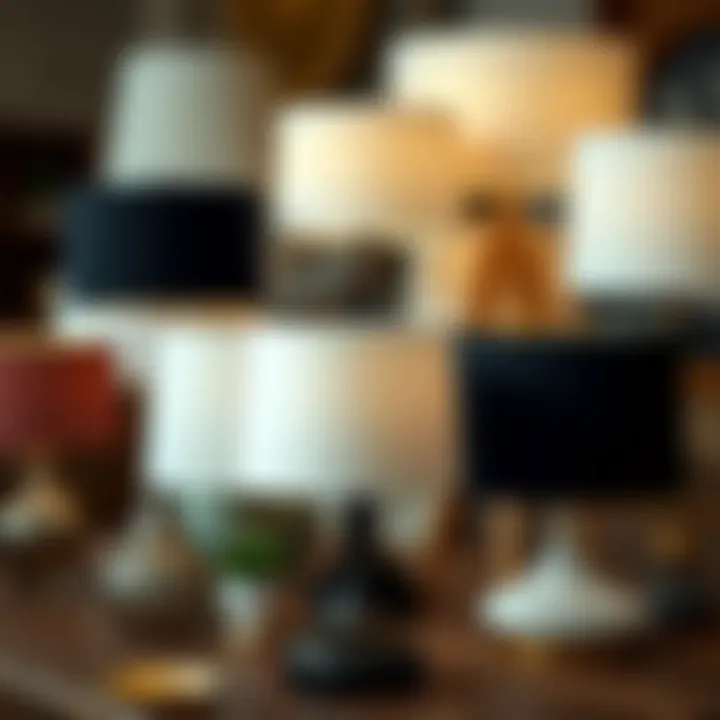
By staying mindful of these factors, you can ensure that your floor lamps contribute positively to your space, providing both light and style.
Types of Floor Lamp Shades
When it comes to floor lamps, the type of shade you choose plays an essential role in how the light gets diffused and how your space looks overall. Selecting the right shade is not just about aesthetics; it's about functionality too. Different materials, styles, and designs can either enhance or inhibit your lamp's ability to provide light effectively. Knowing the different types will help you make a choice that suits both your practical needs and your decorating style.
Common Shade Materials
Fabric
Fabric shades are often celebrated for their warmth and ability to soften light. When you walk into a room lit by a lamp with a fabric shade, you often feel an inviting glow. One key characteristic of fabric is its ability to diffuse light gently, creating a cozy ambiance. It’s a popular choice for those looking to create a relaxed atmosphere.
Unique features include:
- Wide variety of colors and patterns allowing for personal expression.
- Many fabrics can be easily cleaned but often need to be replaced more frequently.
However, a disadvantage might be that fabric shades can occasionally be challenging to maintain, especially if they attract dust or stains. Still, many people find the benefits outweigh the drawbacks, making fabric shades a favored choice.
Glass
Glass shades bring a certain elegance and sophistication to any space. This material has a key characteristic of being able to conduct light beautifully, often creating prisms of color that can dance around the room. Glass shades can also be most suitable for modern or industrial decor, giving a sleek look that’s hard to beat.
Unique features include:
- Durable and long-lasting, making them a sound investment.
- They can easily be cleaned with just a bit of glass cleaner.
On the flip side, glass shades can be heavier, and if you have small kids or pets, they might require extra caution to avoid breakage.
Metal
Metal shades, while not as common as fabric or glass, have their own appeal. They provide a contemporary edge and are often used in design schemes that favor industrial themes. One of the key characteristics of metal is its sturdiness, promising durability and authority in a room.
Unique features include:
- Excellent at directing light, making them highly functional.
- Available in many finishes, such as brass or brushed nickel, each adding its character.
Metal shades can sometimes cast harsh light if not paired correctly, leading to a feeling that the room is too stark or cold, but the right combination can yield perfect results.
Plastic
Plastic shades may often get a bad rap for being cheap, but they can offer surprising advantages. Their main characteristic is versatility. They can come in numerous shapes, colors, and designs, making it easy to find something that fits your needs.
Unique features include:
- Lightweight and easy to transport or change out when the mood strikes.
- Generally less expensive than other materials.
However, one drawback is that plastic shades can discolor over time and might not provide that rich, warm glow typical of fabrics or glass. Choosing a high-quality plastic can alleviate some of these concerns.
Variety of Styles
Understanding the various styles of lampshades is another vital aspect. Each style has its unique charm and can dictate the overall vibe of your space. Whether you're after something traditional like a bell shade or leaning towards the sleek look of a drum shade, selecting the right style can help accentuate your home’s decor.
Selecting the Right Lampshade
Choosing the right lampshade can feel like a daunting task, especially when you consider the variety of options available today. It's about more than just slapping a shade onto your floor lamp; it's a matter of enhancing your living space's ambiance while serving a practical purpose. The lampshade affects not only the light's distribution but also sets the tone for your room. Thus, evaluating your selection carefully can make a world of difference in your interiors.
Assessing Size and Fit
When it comes to lampshades, size does matter, and it can determine how well your lamp serves its intended purpose. A shade that is too small may barely diffuse the light, while one that is too large could overpower the space. In simple terms, you want a proportionate match that aligns with the lamp's base and the surrounding decor. For instance, a sleek, slender floor lamp benefits from a more minimalist shade, as adding a bulky option can clutter the visual aesthetic.
To get a better grasp on what would fit best, measure the height of the lamp from the base to the top and consider the overall height of the shade itself. A good rule of thumb is that the bottom of the lampshade should be around eye level when you're seated.
Color and Pattern Considerations
Color and pattern have an undeniable impact on the room's dynamics. Choosing a bright, bold color can serve as an anchor or statement piece, while a neutral shade often blends in, cultivating a more cohesive look. When considering patterns, think about the existing textiles and colors in your space. If your room is already busy with patterned furniture or curtains, a solid color lampshade might do wonders by creating balance.
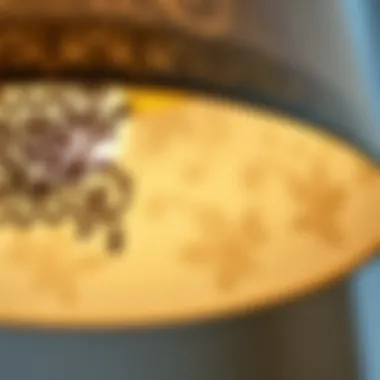
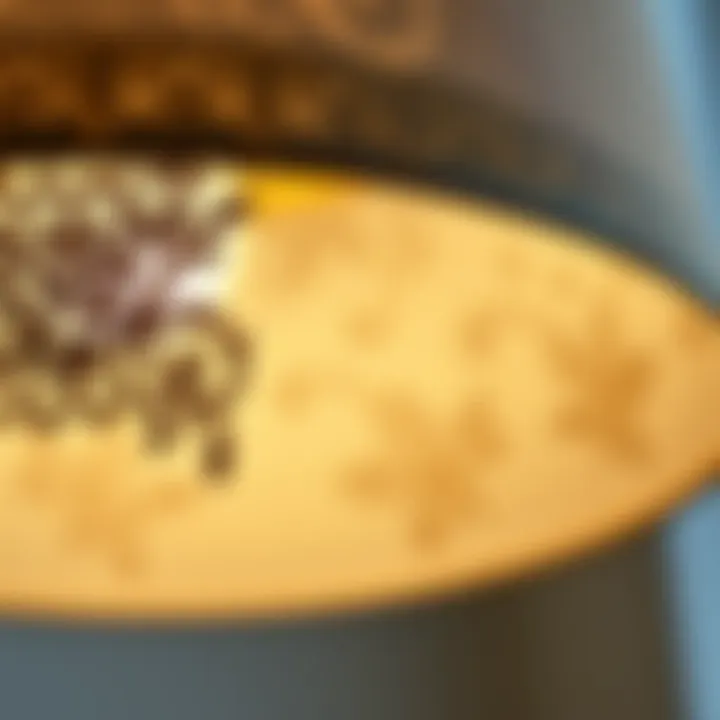
In contrast, if the rest of the room is reserved in its tones, a patterned shade could introduce an element of surprise and charm. However, this is also where personal taste comes into play. Balancing between trendy choices and what resonates with your style is key.
Matching with Your Decor Style
Every home has a heartbeat, dictated by its decor style, and the lampshade should fit snugly into this rhythm. Whether your interior leans towards vintage elegance, modern simplicity, or a bohemian flair, perusing lampshade options should reflect this essence.
For instance, if your living space is characterized by contemporary design, consider sleek glass or metallic shades that enhance minimalism. On the other hand, a plush fabric shade might better suit a cozy, traditional setting. Look around your space—what does it tell you? Use that as a guide in your selection process.
All in all, selecting the right lampshade involves a blend of practical measurements and a palate of colors and styles that resonate with your personal aesthetics. It’s about creating an environment where light portraiture is not just functional but also enriching to your everyday life.
"Light isn't just a utility; it's an art form, and choosing the right lampshade is part of this creative expression."
By approaching the selection of your lampshade with intent and consideration of these elements, you are not merely making a purchase; you are engaging in a thoughtful enhancement of your living space.
Finding the Perfect Replacement Shade
Finding the ideal lampshade is about more than just aesthetics; it's an essential part of ensuring your floor lamp not only looks great but also performs its function effectively. An appropriate lampshade can help direct light where it’s needed, enhance your decor, and even regulate the ambience of your space. After all, the right shade can breathe new life into an old lamp or seamlessly fit into a well-planned room design. Consideration of size, material, style, and color can make all the difference in achieving the look and utility you desire.
Local Stores vs. Online Shopping
When it comes to purchasing a replacement lampshade, the choice between local stores and online shopping isn’t straightforward. Each option has its unique advantages.
Local Stores:
- Immediate Gratification: Walking into a store offers instant access to products—you can touch and feel the materials.
- Personal Consultation: Sales staff often provide guidance that helps narrow down choices based on your specific needs.
- Visual Match: It's easier to see how a lampshade looks next to your lamp and within your space.
However, local stores may have limited selections. If you're searching for something specific or want a unique design, your options might be restricted.
Online Shopping:
- Wider Selection: Online platforms often stock a greater variety of styles and materials, including hard-to-find options.
- Comparison Shopping: It's easier to find competitive prices and read customer reviews from the comfort of home.
- Convenience: Shopping online is a time-saver; you can explore a broader range at your own pace.
On the flip side, online shopping comes with its own challenges. The appearance of shades on a screen may not accurately reflect their true color and texture. Additionally, shipping times and return policies can be inconvenient if you need a quick solution.
Identifying Reputable Brands
Finding a reputable brand can feel like navigating a minefield, especially with so many options in the market. A few pointers can ease that journey:
- Research: Look for brands with positive consumer reviews and testimonials. Check out sites like Reddit or specialized forums where enthusiasts share their experiences.
- Quality Indicators: Reputable brands often use high-quality materials and offer warranties for their products. You want a lampshade that not only looks good but lasts long too.
- Customer Service: Consider companies known for their excellent customer service. Should you face any issues or need support, responsive service is invaluable.
You might also want to consider brands that focus on sustainability and eco-friendly materials. This trend is on the rise, reflecting a growing awareness of environmental responsibilities among both manufacturers and consumers. Partners like Wayfair or West Elm often feature unique designs while emphasizing sustainability.
Before you finalize your choice, have a list of criteria handy. Think of functionality alongside your aesthetic goals, to ensure your new lampshade elevates your room’s character without compromising on the light quality.
Choosing the right replacement shade can transform a mundane space into a beautifully lit sanctuary.
By tackling the shopping process thoughtfully, you can enhance your lighting set-up and ultimately, your interior design.
Installation of Floor Lamp Shades
Installing a new lampshade on a floor lamp is not just a matter of practicality; it significantly affects the lamp's functionality and aesthetic value within a room. The right installation ensures that the light emitted is properly diffused, setting the tone for the space. Additionally, a well-installed shade maintains the visual balance of the lamp, highlighting its design rather than overshadowing it with careless fitting. It can be satisfying to transform a tired piece of furniture into a fresh focal point with just a new shade.
Tools and Materials Needed
Before you dive into the installation, gathering the necessary tools and materials can make the job smoother than a well-oiled machine. Here's a checklist of what you might need:
- Lampshade: Choose one that fits your style and the lamp's specifications.
- Lightbulb: Ensure the wattage matches the lampshade and lamp frame.
- Ladder or Step Stool: If your lamp is tall, a step stool comes in handy.
- Screwdriver: A basic tool in case you need to tighten any screws on the lamp.
- Tape Measure: For measuring the fitter size if you are replacing the shade.
- Soft Cloth or Microfiber: This helps to clean the lamp before and after installation.
Having these items handy means you won’t have to stop midway to find what you need, which can lead to unnecessary fumbling and frustration.
Step-by-Step Installation Process
The installation of your new shade is a straightforward task if you follow these steps:
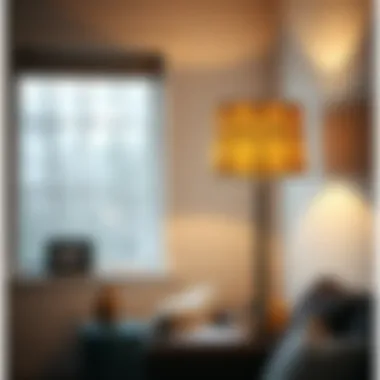
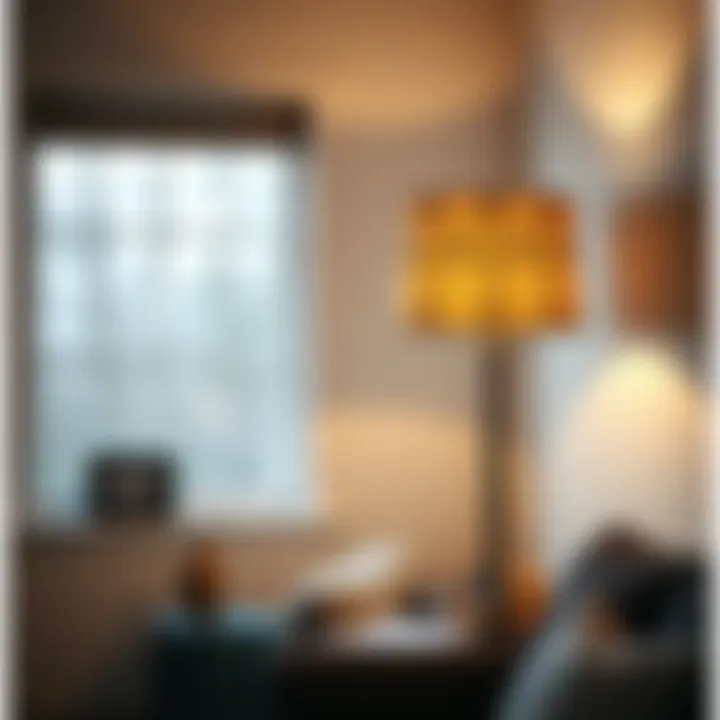
- Turn Off the Power: Always start by switching off the lamp to avoid any accidents. Safety first!
- Remove the Old Shade: Gently take off the existing shade. This often involves unscrewing a top cap or unhooking it, depending on the type of lamp you have.
- Clean the Lamp Base: Use your soft cloth or microfiber to wipe down the lamp. Dust and grime can build up, and cleansing it enhances the overall look.
- Check the Lightbulb: Inspect the lightbulb. If it's dim or flickering, this might be a good time to replace it too. Ensure it’s compatible with your new shade.
- Position the New Shade: Place the new shade onto the fitting. Be mindful of the type of fitter—whether it’s a spider fitting or a clip-on—because this determines how you secure it.
- Secure the Shade: If your shade requires it, tighten the screw cap or secure it in place. Ensure it’s snug but not overly tight to avoid damaging it.
- Test the Lamp: Finally, turn your lamp back on. Observe whether the light distribution meets your expectations. You want a soft glow that adds warmth to the room, not a glaring brightness.
- Final Adjustments: If needed, adjust the shade or bulb position to achieve the desired effect. Remember that small changes can make a big difference.
"A little patience and care during installation can bring big rewards in functionality and appearance."
With thoughtful execution, you can easily breathe new life into your floor lamp, creating a harmonious blend of elegance and practicality.
Caring for Your Floor Lamp Shade
Caring for your floor lamp shade is far more than a trivial task. It’s about preserving the aesthetic and functional quality of a lamp that likely serves as a focal point in your room. Just as you’d maintain a cherished painting or a beloved piece of furniture, investing time and effort into your lampshade helps enhance the ambiance of your living space. The right care prolongs its lifespan, boosts the overall atmosphere, and retains the vibrancy of your decor.
Cleaning Techniques by Material
Each lampshade material requires a different cleaning approach. Here are some techniques personalized for the most common materials:
- Fabric Shades: These can attract a fair bit of dust and grime. It’s best to use a feather duster or a vacuum with a brush attachment on the lowest setting to avoid damaging the fabric. For deeper cleaning, consider using a damp cloth with mild soap, but you should dab gently rather than scrub.
- Glass Shades: These beauties can be polished to regain their clarity. A mixture of water and vinegar works wonders here. Simply spray the solution onto the surface, wipe with a microfiber cloth, and voila! No streaks, just shine.
- Metal Shades: Metals can tarnish over time. A soft cloth with a few drops of metal polish can help. Remember to be gentle during this process to avoid scratching or scuffing the finish.
- Plastic Shades: This material is pretty low maintenance. You can wash it with warm soapy water and dry it with a lint-free cloth to keep it looking fresh.
Remember, regular maintenance ensures that your lampshade remains attractive and functional. Ignoring that dust or grime can lead to a dull appearance or even damage.
Maintaining Shape and Structure
Lampshades can lose their shape over time due to heat exposure or improper handling. Here’s how to maintain their structure effectively:
- Avoid Excessive Heat: Choosing the right bulb is crucial. LEDs emit less heat compared to incandescent bulbs and are generally friendlier to your shades.
- Store Properly: If you need to take your lampshade down, store it upright, in a box if possible. Placing it flat might lead to bending or deformation.
- Use Maintenance Accessories: There are specialized shades supports designed to help maintain the shape of softer fabric shades. These can make a world of difference in preventing sagging or warping.
- Inspect Regularly: Just like you would check for bulb burnout, inspecting your shades for any signs of wear or damage can help catch problems before they escalate.
"A lamp without a proper shade is like a cake without icing—sure, it serves its purpose, but where's the charm?"
By integrating these practices into your care routine, your floor lamp shade won’t just survive; it will thrive, contributing to a warm and inviting environment. Remember, a little love goes a long way in keeping your shades looking fresh and helping them last through the years.
Current Trends in Floor Lamp Shades
Understanding the ongoing transformations in floor lamp shade designs is crucial. Not only do trends indicate what's currently captivating attention, but they also shape functionality and visual appeal. A well-chosen lampshade does more than simply cover a bulb; it orchestrates the ambiance of a room and complements the overall décor. With consumers more inclined towards uniquely personalized spaces, keeping abreast of current trends can offer invaluable insights and opportunities for enhancement.
Sustainable Materials
One cannot overlook the surge in popularity of sustainable materials within the lampshade market. Increasing awareness of environmental issues has propelled many homeowners and designers to seek eco-friendly options. Shades made from natural fibers like jute, bamboo, and recycled fabrics are gaining traction for their minimal environmental impact. Not only do these materials contribute to a healthier planet, they also bring warmth and texture to a living space.
- Benefits of Sustainable Materials:
- Eco-Friendly: Reduces carbon footprint.
- Unique Aesthetics: Often features organic textures and colors.
- Durability: Many sustainable materials offer unexpected longevity.
Using these materials can tell a compelling story about choice and conscientious design. Buyers are increasingly attracted to the narrative behind the products they select, making the choice more than just functional; it becomes a reflection of their values.
Minimalistic Designs
The minimalistic design trend, with its roots in the idea that 'less is more,' has made significant inroads in the world of floor lamp shades. Stripped of all ornamentation, these shades emphasize clean lines and simple forms. With an increasing number of households favoring uncluttered, serene spaces, minimalistic designs resonate with many seeking to cultivate calmness through their décor.
- Characteristics of Minimalistic Designs:
- Neutral Color Palettes: Emphasizes simplicity and harmony.
- Geometric shapes: Often features basic patterns that celebrate form over embellishment.
- Materials: Frequently utilizes glass, metal or simple fabrics that are both functional and visually appealing.
Homeowners can create stunning looks with minimalistic shades without overwhelming the room. These designs let light take center stage, contributing to an elegant ambiance while simplifying visual clutter.
"When you remove all the excess, what remains is not just beautiful, it’s a testament to thoughtful design."
End and Final Thoughts
As we draw the curtain on this exploration of floor lamp shade replacements, it becomes clear that the choice of lampshade is pivotal to both functionality and aesthetics within a home. It's not just about picking a pretty covering; it's about creating the right ambiance, ensuring proper light diffusion, and complementing your existing decor.
Recapping Shade Replacement Importance
To put it succinctly, replacing your floor lamp shade can breathe new life into your living space. Over time, fabric can fray, colors can fade, and designs may become outdated, making an old shade less appealing. Updating a lampshade isn’t merely a cosmetic fix, but a chance to redefine the character of your room. A new shade can transform a dim corner into a welcoming nook or turn a mundane lamp into a statement piece. Moreover, the right shade impacts how light spreads throughout the area, highlighting features of your home that you wish to bring attention to.
- Enhanced Lighting: A well-chosen shade modifies the light quality, creating an inviting atmosphere. The material and color can soften harsh lighting or accentuate warm tones.
- Aesthetic Harmony: Selecting a shade that complements your interior style ties the room together. Whether it’s contemporary, vintage, or eclectic, the shade choice acts as a bridge linking various elements of your decor.
Inspiring Your Lighting Choices
Your lighting ought to resonate with your personality and lifestyle. When considering new lampshades, think beyond mere function—explore how these changes can infuse your space with character. For instance, if you lean towards bohemian vibes, a colorful woven shade might do the trick, while a sleek, metallic shade could suit modern minimalism.
Getting inspired involves looking at different styles, textures, and technologies. Don’t shy away from browsing platforms like Pinterest or visiting local boutiques. Take notes of what resonates with you. Think about layering light sources and using shades in various ways across your space.
Finally, remember that lighting isn’t static; it evolves. Embrace the idea that your choices today could lead to an inspiring transformation tomorrow. By making informed decisions about floor lamp shades—based on size, color, material, and design—you can significantly impact the overall feel of your home. Your lamp is not just a source of light; it’s a storytelling piece in your interior narrative.



